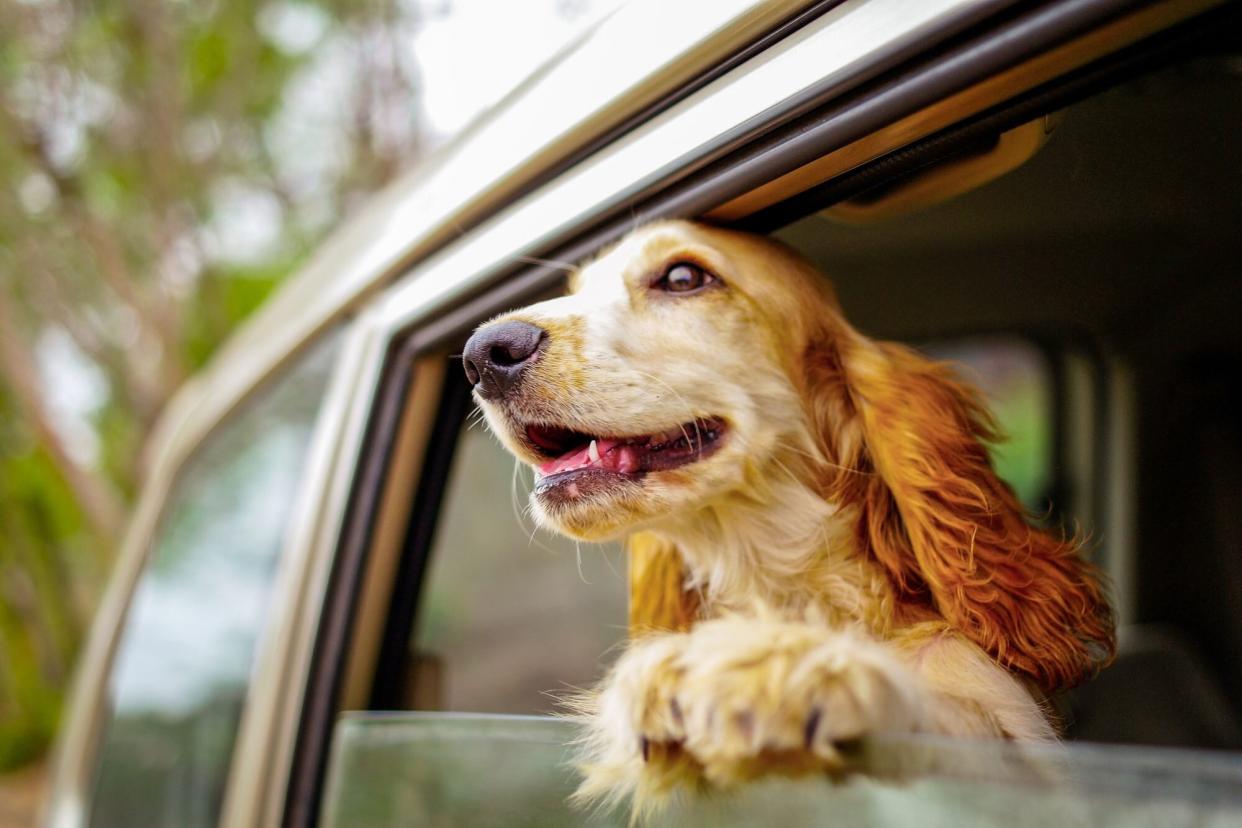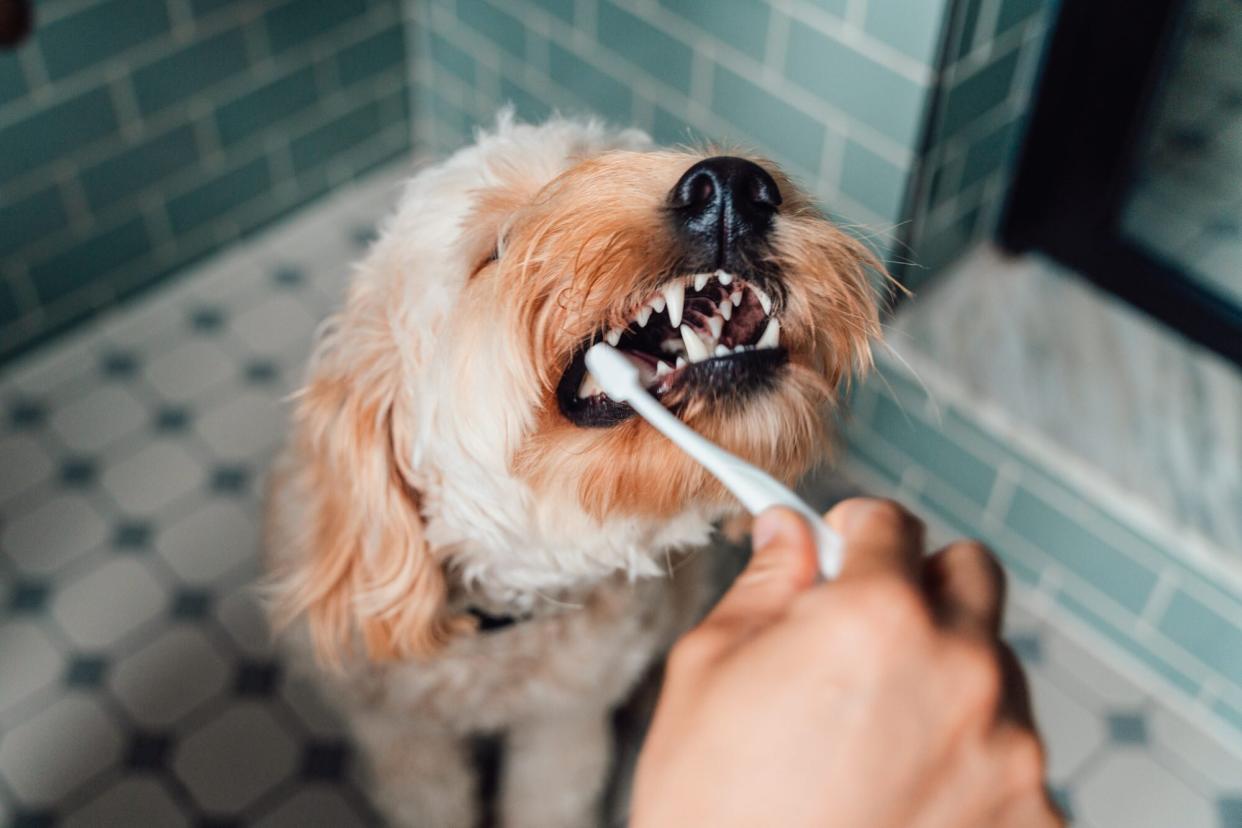The right way to clean your dog's teeth, according to veterinarians
If there's anything we know for sure about our dogs, it's that we love them and want to make sure they stay happy and healthy. From giving them baths to brushing their teeth, we know that tending to their needs will make sure that they feel and look their best.
When it comes to the latter task, remember that canines need their teeth cleaned at least every few days to prevent plaque and tartar buildup. If their teeth are not tended to, these conditions could lead to anything from gum disease to sensitive teeth. Want to know how to get your pets' teeth clean and sparkling? We asked veterinarians all about teeth cleaning best practices, including how to now when it's time to get your dog professional care.
Related: How to Clean Your Dog's Ears the Right Way, According to Veterinarians
How Often to Clean Your Dog's Teeth
Veterinarians recommend brushing your dog's teeth every day. But if you can't follow this cleaning cadence, at least try to brush your dog's teeth every three days, says Sarah Wooten, DVM, a Colorado-based veterinarian and a contributor to Covetrus Great Pet Care. "That is because it takes [about] 72 hours for plaque (the white, squishy biofilm that accumulates on teeth but can be easily removed) to harden into tartar (hard tan or brown [deposits that] can't be brushed off).

How to Get Your Dog Comfortable With Teeth Cleaning
The best way to acclimate your dog to getting their teeth cleaned is by getting them used to someone working in their oral cavity, says Athena Gaffud, DVM at Veterinarians.org; giving them a few treats before beginning the cleaning process can help, too.
Massage
Massage your dog's mouth area with your fingers every day to get them familiar with this process, Dr. Gaffud says. "Have your dog sit comfortably and make a gentle circular motion in the lips for about a minute or two and gradually move toward the gums and teeth," she says. She recommends giving your dog about a few weeks to get comfortable with the massage.
Dog Rewards
From there, give your pet rewards, says Rhiannon Koehler, DVM, shelter veterinarian, veterinary writer, and contributor to Covetrus Great Pet Care. "If you pick a desirable flavor of pet toothpaste, your pet may view the toothpaste itself as a treat," she says. "You can help your dog associate the toothpaste with a reward if you begin to give them a taste of the toothpaste as a treat prior to using it for dental cleanings." As another option, you can let your canine taste the toothpaste and then follow up with a treat. The ultimate goal should be to get your dog used to (and even excited!) about trying the toothpaste.
Starting the Cleaning Process
Once your dog is accustomed to the taste of the toothpaste, you can start applying it to their teeth and gums with your finger and then giving them a treat to follow. After they get used to the toothpaste on their teeth, you can start using a finger brush or washcloth to lightly clean their teeth for short periods of time. At this point, you should be good to go to proceed with a more formal cleaning, which includes the use of a soft-bristle toothbrush and a longer brush time. "Most dogs will do well with this process, but if your dog is attempting to bite you, please discontinue trying to get your dog to accept toothbrushing and follow up with your veterinarian or a behaviorist," says Dr. Koehler.

How to Clean Your Dog's Teeth
Make sure that you brush your dog's teeth with a toothpaste formulated for pets—never a human toothpaste. "Human toothpaste contains fluoride, which is toxic if swallowed by pets," says Dr. Wooten. "Pet toothpaste uses enzymes to clean a pet's teeth and comes in flavors they like."
Materials You'll Need
Pet toothpaste
Toothbrush, finger brush, or pet dental wipe
Treats or rewards
Follow these expert-approved steps to clean your dog's teeth:
Wet the toothbrush and apply a generous amount of toothpaste to the brush. If you have a small dog or if they are uncomfortable with a toothbrush, you can use a finger brush or a pet dental wipe wrapped around your finger.
Begin scrubbing the back teeth and gradually move forward, making sure to brush both the top and bottom teeth, says Dr. Koehler. "You can pause to give your pet a treat between each section of their mouth if needed," she says. "You do not need to rinse your dog's mouth after brushing their teeth. (Dog toothpaste is safe for them to swallow.)"
Gently pull back your dog's lips to get the smaller molars in the very back of the dog's mouth, behind the big teeth. Only clean on the outside of the teeth, not the inside.
Brush for a full minute if possible.
When to Seek Veterinary Care
Even if you regularly brush your dog's teeth, make sure to have your pet's dental health evaluated by their veterinarian during their annual or biannual check-ups, says Dr. Koehler. "Your veterinarian will recommend professional cleanings and other dental care as needed," she says.
Treating Tartar and Gum Disease
Veterinarians will need to use professional tools to scrape tartar from your dog's teeth—this isn't something you can handle at home, so if you see it, call your pet's doctor. "This requires anesthesia in a veterinary office and is usually done as an outpatient procedure (dog dropped off in the morning, picked up in the afternoon)," says Dr. Wooten. "In addition, gum disease is painful and will likely make teeth brushing hurt, which will make it harder to accomplish."
Dental Exams
Your dog will need to get dental prophylaxis done by a professional at least once each year. "A detailed exam and dental X-rays are necessary once you see tartar buildup," says Dr. Gaffud. "There are frequently painful problems hidden under the gumline that we cannot see by simple physical exam." Tartar under the gumline actually causes most problems, and professionals will need to treat it.
Sensitive Teeth and Gums
If your dogs have sensitive teeth and gums, you'll need to consult with a veterinarian for brushing or treatment options. "Depending on the case, they might need to see their vet more often," says Dr. Gaffud. "Geriatric pets (older than 7 to 8 years old) should see their veterinarian twice a year or more frequently to identify possible problems as soon as possible."
